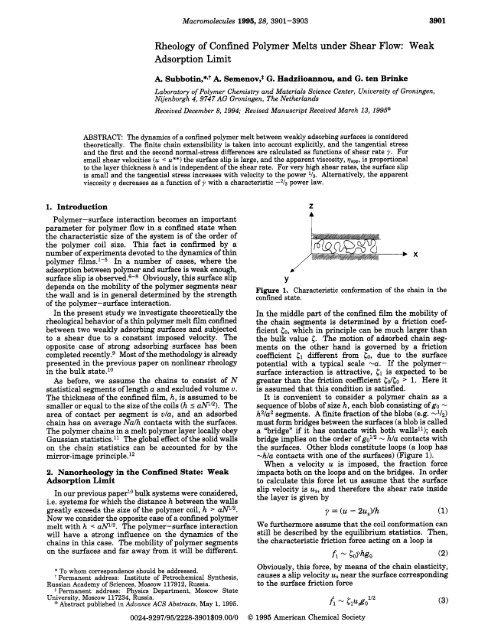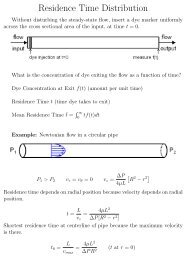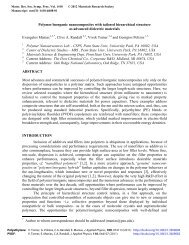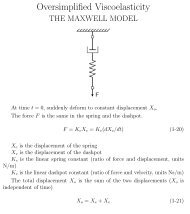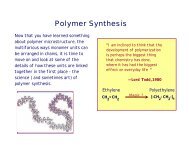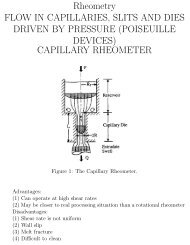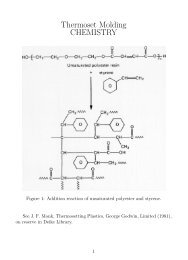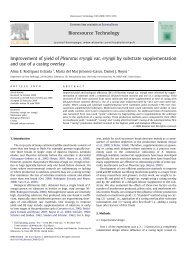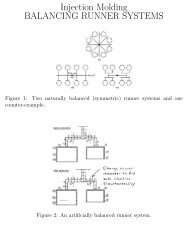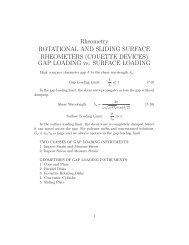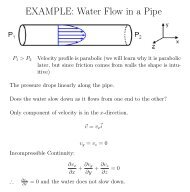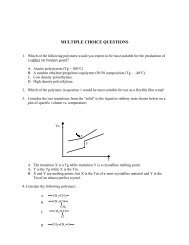Rheology of Confined Polymer Melts under Shear Flow: Weak ...
Rheology of Confined Polymer Melts under Shear Flow: Weak ...
Rheology of Confined Polymer Melts under Shear Flow: Weak ...
You also want an ePaper? Increase the reach of your titles
YUMPU automatically turns print PDFs into web optimized ePapers that Google loves.
+ PermanentMacromolecules 1996,28, 3901-3903 3901<strong>Rheology</strong> <strong>of</strong> <strong>Confined</strong> <strong>Polymer</strong> <strong>Melts</strong> <strong>under</strong> <strong>Shear</strong> <strong>Flow</strong>: <strong>Weak</strong>Adsorption LimitA. Subbotin,**t A. Semenov? G. Hadziioannou, and G. ten BrideLaboratory <strong>of</strong> <strong>Polymer</strong> Chemistry and Materials Science Center, University <strong>of</strong> Groningen,Ngenborgh 4, 9747 AG Groningen, The NetherlandsReceived December 8, 1994; Revised Manuscript Received March 13, 1995@1. IntroductionABSTRACT The dynamics <strong>of</strong> a confined polymer melt between weakly adsorbing surfaces is consideredtheoretically. The finite chain extensibility is taken into account explicitly, and the tangential stressand the first and the second normal-stress differences are calculated as functions <strong>of</strong> shear rate 9. Forsmall shear velocities (u -= u**) the surface slip is large, and the apparent viscosity, qapp, is proportionalto the layer thickness h and is independent <strong>of</strong> the shear rate. For very high shear rates, the surface slipis small and the tangential stress increases with velocity to the power V3. Alternatively, the apparentviscosity q decreases as a function <strong>of</strong> y with a characteristic -2/3 power law.<strong>Polymer</strong>-surface interaction becomes an importantparameter for polymer flow in a confined state whenthe characteristic size <strong>of</strong> the system is <strong>of</strong> the order <strong>of</strong>the polymer coil size. This fact is confirmed by anumber <strong>of</strong> experiments devoted to the dynamics <strong>of</strong> thinpolymer film~.l-~ In a number <strong>of</strong> cases, where theadsorption between polymer and surface is weak enough,surface slip isObviously, this surface slipdepends on the mobility <strong>of</strong> the polymer segments nearthe wall and is in general determined by the strength<strong>of</strong> the polymer-surface interaction.In the present study we investigate theoretically therheological behavior <strong>of</strong> a thin polymer melt film confinedbetween two weakly adsorbing surfaces and subjectedto a shear due to a constant imposed velocity. Theopposite case <strong>of</strong> strong adsorbing surfaces has beencompleted re~ently.~ Most <strong>of</strong> the methodology is alreadypresented in the previous paper on nonlinear rheologyin the bulk state.1°As before, we assume the chains to consist <strong>of</strong> Nstatistical segments <strong>of</strong> length a and excluded volume u.The thickness <strong>of</strong> the confined film, h, is assumed to besmaller or equal to the size <strong>of</strong> the coils (h I UN'~). Thearea <strong>of</strong> contact per segment is ula, and an adsorbedchain has on average Nalh contacts with the surfaces.The polymer chains in a melt polymer layer locally obeyGaussian statistics.ll The global effect <strong>of</strong> the solid wallson the chain statistics can be accounted for by themirror-image principle.122. Nanorheology in the <strong>Confined</strong> State: <strong>Weak</strong>Adsorption LimitIn our previous paperlo bulk systems were considered,i.e. systems for which the distance h between the wallsgreatly exceeds the size <strong>of</strong> the polymer coil, h > aW".Now we consider the opposite case <strong>of</strong> a confmed polymermelt with h awl2. The polymer-surface interactionwill have a strong influence on the dynamics <strong>of</strong> thechains in this case. The mobility <strong>of</strong> polymer segmentson the surfaces and far away from it will be different.* To whom correspondence should be addressed.address: Institute <strong>of</strong> Petrochemical Synthesis,Russian Academy <strong>of</strong> Sciences, Moscow 117912, Russia.* Permanent address: Physics Department, Moscow StateUniversity, Moscow 117234, Russia.@ Abstract published in Advance ACS Abstracts, May 1, 1995.z4JYFigure 1. Characteristic conformation <strong>of</strong> the chain in theconfined state.In the middle part <strong>of</strong> the confined film the mobility <strong>of</strong>the chain segments is determined by a friction coefficient50, which in principle can be much larger thanthe bulk value 5. The motion <strong>of</strong> adsorbed chain segmentson the other hand is governed by a frictioncoefficient 51 different from 50, due to the surfacepotential with a typical scale -a. If the polymer-surface interaction is attractive, 51 is expected to begreater than the friction coefficient 5dCo =- 1. Here itis assumed that this condition is satisfied.It is convenient to consider a polymer chain as asequence <strong>of</strong> blobs <strong>of</strong> size h, each blob consisting <strong>of</strong> go -hzla2 segments. A finite fraction <strong>of</strong> the blobs (e.g. 4 2 )must form bridges between the surfaces (a blob is calleda "bridge" if it has contacts with both walls'l); eachbridge implies on the order <strong>of</strong> - hla contacts withthe surfaces. Other blods constitute loops (a loop has-hla contacts with one <strong>of</strong> the surfaces) (Figure 1).When a velocity u is imposed, the fraction forceimpacts both on the loops and on the bridges. In orderto calculate this force let us assume that the surfaceslip velocity is us, and therefore the shear rate insidethe layer is given byp = (u - 2UJh(1)We furthermore assume that the coil conformation canstill be described by the equilibrium statistics. Then,the characteristic friction force acting on a loop isfi - 5oYhgo (2)Obviously, this force, by means <strong>of</strong> the chain elasticity,causes a slip velocity us near the surface correspondingto the surface friction forcefl - 51ugo1'2 (3)0024-9297/95/2228-3901$09.00/0 0 1995 American Chemical Society
3902 Subbotin et al.Macromolecules, Vol. 28, No. 11, 1995“ t4 F 4 I 7R-aN11Figure 2. Characteristic conformation <strong>of</strong> a chain before andafter the transition point.From the condition f1 = fl the slip velocity is found tobeIn this regime, the slip is large, if the parameter ,B > 1 was investigated in ref 9. Forp
Macromolecules, Vol. 28, No. 11, 1995 <strong>Rheology</strong> <strong>of</strong> <strong>Confined</strong> <strong>Polymer</strong> <strong>Melts</strong> 3903InInXLFigure 4. Plot <strong>of</strong> tangential (uxz) and normal (NI) stressesand the apparent viscosity (rapp) as a function <strong>of</strong> shear rateYawconsidered as being independent from each other becausethere are no long-range correlations along thechain. Therefore, the tangential and normal stressesfor this case must be the same as in the bulk <strong>of</strong> chainscontaining go segments. Hence, the final results canbe obtained from the corresponding results in the bulk(ref 10, eqs 4 and 14) by substitutinggo for N and zo forzN, = 0The apparent viscosity, qapp, can be defined asEquations 17 and 18 imply thatwhereVapp = ax&/u (18)vaPp - p-2/3~01/3/~ u ’ u**u** -Note that u** >> u* and that in the region u > u** theslip is small (see eq 15b).The qualitative dependence <strong>of</strong> a, NI, vaPp as afunction <strong>of</strong> shear rate is shown in Figure 4. The first- u*, or 3 - l/(zag~~’~),normal-stress difference N1 has a jump in the point ubecause the chain changes itsconformation at this point from Gaussian to elongated.3. Discussion and ConclusionsIn this paper we present a theory for nonentanglementpolymer melts confined between two weaklyadsorbing surfaces. Our calculations show that thechain nonlinearity has pr<strong>of</strong>ound influence on the surfaceslip behavior. The slip is large for small enough shearrates only, when the chains are still close to Gaussian.For high shear rates, the chains become stronglyelongated along the flow direction and, due to thenonlinearity, compressed in the normal direction. Thisfact leads to a decreasing surface slip.The principal difference between bulk and confinedmelt consists <strong>of</strong> the scale <strong>of</strong> the relaxation times.Although, a consistent description <strong>of</strong> relaxation processesin the confined melt does not exist yet, experimentsdo sho~l-~ that the relaxation processes arestrongly suppressed in the confined state. As a resultnonlinear behavior for confined polymer melts occursat much smaller shear rates, as manifested by theinverse proportionality <strong>of</strong> the critical shear velocity u*to the segmental relaxation time zo.Acknowledgment. This research was supported bythe Netherlands Foundation <strong>of</strong> Technology (SON STW)and the Netherlands Organization for Scientific Research(NWO). The authors are grateful to Dr. E.Manias for discussions.References and Notes(1) Gee, M. L.; McGuiggan, P. M.; Israelachvili, J. N.; Homola,A. M. J. Chem. Phys. 1990,93, 1895.(2) Homola, A. M.; Nguyen, H. V.; Hadziioannou, G. J. Chem.Phys. 1991,94, 2346.(3) Hu, H.; Carlson, G. A.; Granick, S. Phys. Rev. Lett. 1991,66,2758.(4) Granick, S. Science 1992,253, 1374.(5) Hu, H.; Granick, S. Science 1991,258, 1339.(6) De Gennes. C. R. Acad. Sci. Paris 1979.288B. 219.(7) Thompson,’P. A.; Grest, G. S.; Robbins,’M. Phys. Reu. Lett.1992, 68, 3448.(8) Manias. E.: Hadziioannou. G.: Ten Brinke. G. J. Chem. Phvs.I ,‘ 1994, 101,’1721.(9) Subbotin, A.; Semenov, A. N.; Manias, E.; Hadziioannou, G.;Ten Brinke, G. Macromolecules 1995,28, 1511.(10) Subbotin, A.; Semenov, A. N.; Manias, E.; Hadziioannou, G.;Ten Brinke, G. Macromolecules 1995,28, 3898.(11) De Gennes, P. G. Scaling Concepts in <strong>Polymer</strong> Physics, 2ndprinting; Cornel1 University Press: Ithaca, New York, 1985.(12) Bitsanis, I. A.; Ten Brinke, G. J. Chem. Phys. 1993,99,3100.MA9462060


